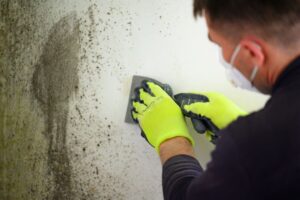Back to Basics is a weekly feature that highlights important but possibly overlooked information that any EHS professional should know. This week, we examine how to prevent worker exposure to mold.
There are many hazards in the workplace, but one of the most insidious is mold. Exposure to mold and fungus can lead to health problems for workers, so you need to keep an eye on it.
According to the Occupational Health and Safety Administration (OSHA), most people experience no health effects from exposure to the molds present in indoor or outdoor air. But some people with underlying health conditions such as allergies or existing respiratory conditions such as asthma, sinusitis, or other lung diseases may be more sensitive to molds.
People with weakened immune systems also tend to be more sensitive to molds. A person’s immune system could be weakened if they have conditions such as pregnancy, diabetes, autoimmune disease, leukemia, or AIDS. This could also be the case if the person is recovering from recent surgery, receiving chemotherapy or long-term treatment with steroids, or if the person is the recent recipient of an organ or bone marrow transplant. Also, infants, children, and the elderly are also more susceptible to health problems caused by molds.
The most common health effects associated with mold exposure include allergic reactions similar to allergies to pollen or animals, according to OSHA. Symptoms include sneezing, runny nose, eye irritation, coughing, congestion, aggravation of asthma, and skin rash. More severe reactions such as hypersensitivity pneumonitis can occur in susceptible people.
Prevention
The key to mold prevention is controlling moisture, OSHA notes. Doing a visual inspection is the most important first step. Conduct regular checks of the building envelope and drainage systems to ensure they are in working order. Identify and eliminate (if possible) sources of dampness, high humidity, and moisture to prevent mold growth. Clean and dry wet or damp spots and wet, non-moldy materials within 24 to 48 hours of discovery.
You can prevent moisture due to condensation by increasing the surface temperature of the material where condensation is occurring, or by reducing humidity. To increase the material’s surface temperature, insulate it from the colder area or increase circulation of warmer air. Reduce the moisture level in the air by repairing leaks, increasing ventilation (if outside air is cold and dry), or dehumidifying (if outside air is warm and humid). Maintain indoor relative humidity below 70% (25% to 60% if possible).
Check all buildings routinely for water leaks, problem seals around doors and windows, and visible mold in moist or damp parts of the building. Correct any conditions that could be causes of mold growth to prevent future mold problems.
Other mold prevention tips include:
- Venting moisture-generating appliances (e.g., dryers) to the outside where possible
- Venting kitchens and bathrooms according to local code requirements
- Providing adequate drainage around buildings and sloping the ground away from the building foundations
- Pinpointing areas where leaks have occurred, identifying the causes, and taking preventive action to ensure they do not reoccur
Check ventilation systems regularly, particularly for damp filters and overall cleanliness. Put a preventive maintenance plan in place for each major component of the building’s ventilation system. Contact your equipment supplier or manufacturer for recommended maintenance schedules and operations and maintenance manuals, according to OSHA. Pay particular attention to components that are exposed to water (e.g., drainage pans, coils, cooling towers, humidifiers) to prevent microbial growth and undesired microorganisms or chemicals entering the indoor air stream.
OSHA recommends cleaning the building’s air ducts, the various heating and cooling system components of forced air systems. These components may become contaminated with mold if moisture is present in the system, which could release mold spores throughout the building.
Failure to clean a component of a contaminated system can result in recontamination of the entire system. Remove and replace water-damaged or contaminated porous materials in the ductwork or other air handling system components. Check ventilation system filters regularly to ensure that they are seated properly. Replace filters on a routine schedule.
During building renovations or remodeling, protect building occupants or workers by isolating the areas undergoing renovations from occupied areas. This can involve erecting barriers made of plywood or polyethylene sheeting. Cover supply and return ducts in the area under renovation to prevent the spread of odors and construction dust. Turn off air handling units serving areas under renovation if they serve only the area being renovated. Lock out air handling units being serviced as part of the renovation. Ensure that the renovated area is under negative or neutral pressure in relation to the adjacent occupied space. Evaluate work areas for potential harm to workers and relocate occupants as needed.
Visible mold on external surfaces, especially on a building’s walls, may be an indicator of more severe contamination beneath the surface, according to OSHA. Mold removal without also correcting the underlying water/moisture problem would not be effective because the mold would grow back. If you suspect your building has mold, consult with an experienced professional to evaluate the situation and recommend or supervise the appropriate corrective action.
Visit OSHA’s Preventing Mold-Related Problems in the Indoor Workplace for more information.

